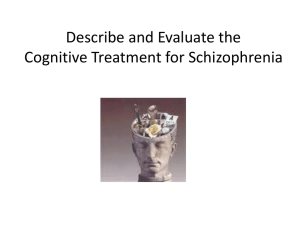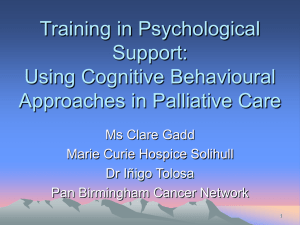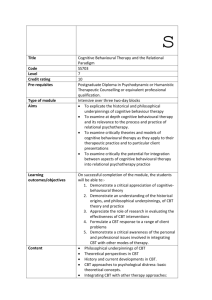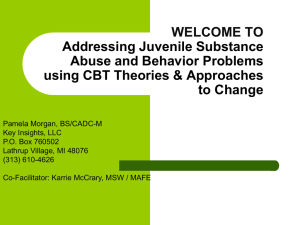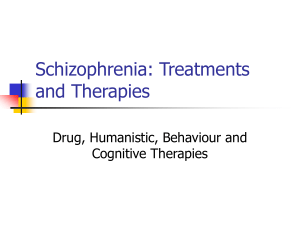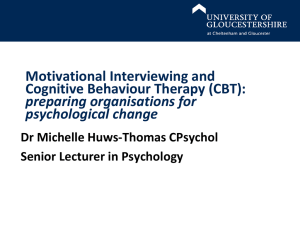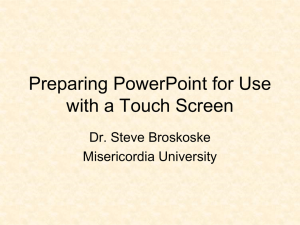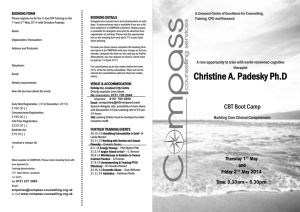CBT – schizophrenia
advertisement
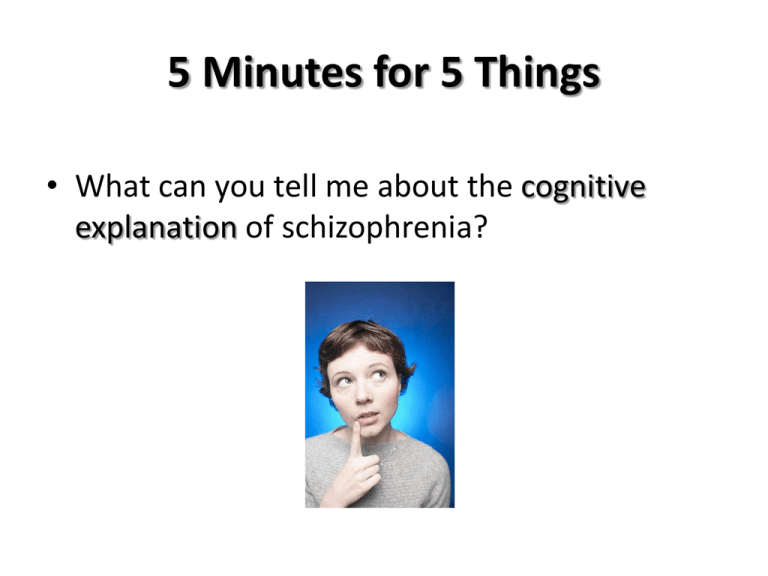
5 Minutes for 5 Things • What can you tell me about the cognitive explanation of schizophrenia? Describe and Evaluate the Cognitive Treatment for Schizophrenia Cognitive Behavioural Therapy (CBT) Map to Spec – Page 59 3 Content g) For schizophrenia describe and evaluate two treatments. Students must select one treatment each from two different approaches studied from the five in Units 1 and 2. Map to Spec – Page 60 • Describe and evaluate one treatment/therapy from each of the following approaches: i. the Social Approach: either Family Therapy or Care in the Community programmes ii. the Cognitive Approach: either Cognitive Behaviour Therapy or Rational Emotive Therapy iii. the Psychodynamic Approach: either free association or dream analysis iv. the Biological Approach: either the use of drugs (chemotherapy) or electro-convulsive therapy (ECT) v. the Learning Approach: either the Token Economy Programme or Systematic Desensitisation. What is CBT? • Therapy which aims to help the patient to identify disordered and delusional thinking • Attempt to replace these with thought processes that are more constructive and more in line with reality • Behavioural element – develop coping strategies CBT The aims of this therapy are as follows: • To help the patient to identify delusions • To challenge delusory beliefs • To challenge those delusions by looking at evidence • To help the patient to begin to test the reality of the evidence An example of a delusional belief Event • Overhearing someone saying “I know what’s on your mind” Interpretation • Everyone can read my thoughts Feeling • Paranoid, scared and believing that others will attack me for my thoughts Behaviour • Take evasive action – avoiding situations that will bring me into contact with others CBT Techniques • Patients are encouraged to trace back to the origins of their symptoms in order to get a better idea of how they may have developed. • Try to help the patient come up with rational alternatives Long-term Help • The therapist encourages patient to come up with their own coping strategies for when they experience any symptoms • They may then receive help and advice about how they can avoid acting on delusional thoughts. CBT course • Most people will require between 8 to 20 sessions of CBT over the space of 6 to 12 months. CBT sessions usually last for about an hour. Your Task • In pairs, assign yourself as either the patient or the therapist. • If you are the patient – explain your delusion • If you are the therapist – use the processes of CBT to attempt to rationalise their belief. • After you’ve had a go at using one example of a delusion, swap your roles around. This type of treatment has been shown to be effective for reducing the positive symptoms of schizophrenia, for reducing relapse and for enhancing recovery when schizophrenia is diagnosed early. Sensky et al (2000) • Studying the effectiveness of CBT • Put the statements in an order that you think represents the study • Use APRC to help you decide on the order Cognitive Treatment Sensky et al. (2000) Aim • To compare cognitive behavioural therapy (CBT) with non-specific befriending interventions for patients with schizophrenia Design • A randomized controlled design. • Patients were allocated to one of two groups: – a cognitive behavioural therapy group. – a non-specific befriending control group. Participants • 90 patients. – 57 from clinics in Newcastle, Cleveland and Durham and 33 from London. They had diagnoses of schizophrenia that had not responded to medication. – Aged 16–60 years. Procedure • • • Patients were allocated to one of two groups. Both interventions were delivered by two experienced nurses who received regular supervision. Patients were assessed by blind raters – at baseline. – after treatment (lasting up to 9 months). – at a 9-month follow-up evaluation. • • • They were assessed on measures including the Comprehensive Psychiatric Rating Scale, the Scale for Assessment of Negative Symptoms, plus a depression rating scale. Patients continued to receive routine care throughout the study. The patients received a mean of 19 individual treatment sessions over 9 months. Cognitive behavioural therapy condition • A normal routine of CBT was used: – – – – – – initially engaging with patient psycho education developing a reason for the behaviour Cognitive and behavioural interventions treatment of other disorders such as depression Reducing relapse by planning ahead CBT Strategies Used • Specific techniques for positive symptoms of schizophrenia were used: – critical analysis of beliefs about auditory hallucinations. – patients were helped to change their beliefs. – patients taught coping strategies to deal with the voices. • Delusions and thought disorders were also addressed using cognitive strategies. Befriending condition • The patients had the same time allocation at the same intervals as patients in the CBT condition. • The therapists were empathic and non-directive. • There was no attempt at therapy: – The sessions focused on hobbies, sports and current affairs. Findings • Both interventions resulted in significant reductions in positive and negative symptoms and depression. • After treatment there was no significant difference between the two groups. • At the nine-month follow-up evaluation, patients who had received cognitive therapy showed greater improvements on all measures. – They had improved, while the befriending group had lost some of the benefits. Conclusions • Cognitive behavioural therapy is effective in treating negative as well as positive symptoms in schizophrenia resistant to standard antipsychotic drugs. • Its efficacy is sustained for at least nine months – effective in teaching patients strategies to cope with symptoms Evaluation of CBT • Complete the card sort activity, deciding between strengths and weaknesses Evaluation of CBT for Schizophrenia Shown to be incredibly effective, e.g. Kuipers et al. (1997) found that when combined with antipsychotic drugs there was a lower drop out rate and greater patient satisfaction. Can be used in conjunction with other therapies and other forms of treatments (i.e. drug treatment) Improves symptoms, recovery and relapse rates No side effects CBT puts patients in charge of their own treatment by teaching self help strategies. Fewer ethical issues than drugs and other treatments Not very rational to teach patients to see life through rose coloured glasses Doesn’t work for everybody i.e. not suitable when the patient are deluding as they cannot fully engage with the therapy Expensive and time consuming CBT works by generating less distressing explanations for negative experiences rather than by eliminating them completely. Patients can become dependent on their therapist Read the Case study and answer the questions on the worksheet Extension Apply your knowledge: • You have a friend who has recently been diagnosed with schizophrenia. She is unsure which treatment to go with – drug, or therapy. How can you help her make the choice? ( note: you need to describe how the treatments work as well as evaluate them)
